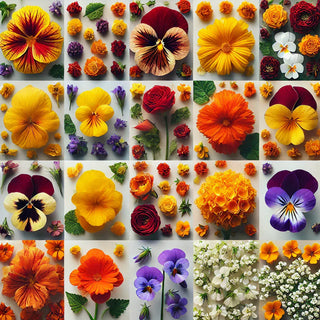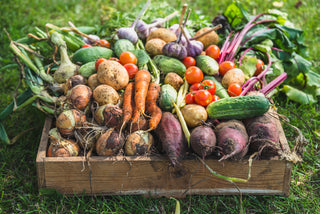1. Viola Johnny Jump Up
Description: A charming, low-growing perennial with delicate, bi-coloured flowers in shades of purple, yellow, and white. The blooms have a whimsical "face-like" pattern, making them a favourite for cottage gardens and borders.
Colours: Purple and yellow with dark veining.
Growth Habit: Compact, spreading habit, ideal for ground cover or containers.
Did You Know? Violas are often called "heartsease" because they were historically used in herbal remedies to soothe heartache.
2. Marigold Honeycomb
Description: A vibrant, bushy annual with double blooms in warm, honey-like shades of orange and yellow. The flowers are densely petaled and have a velvety texture, making them perfect for borders and cut flower arrangements.
Colours: Rich orange and golden yellow.
Growth Habit: Compact and uniform, growing to about 30 cm tall.
Did You Know? Marigold petals are often used as a natural dye for fabrics and foods, adding a golden hue.
3. Rosella (Hibiscus)
Description: A striking tropical plant with large, crimson flowers and a prominent central stamen. The edible calyxes are used to make teas, jams, and sauces. The plant has a tall, upright growth habit with deep green, lobed leaves.
Colours: Bright red flowers with a dark red centre.
Growth Habit: Tall and shrub-like, reaching up to 2 metres in height.
Did You Know? Rosella is a key ingredient in the popular Australian drink "hibiscus tea," known for its tangy flavour and vibrant colour.
4. Calendula Pacific Beauty Mix
Description: A cheerful annual with large, daisy-like flowers in shades of orange, yellow, and apricot. The petals are slightly ruffled, adding texture to garden beds and containers. Calendula is also known for its medicinal properties.
Colours: Bright orange, yellow, and soft apricot.
Growth Habit: Bushy and compact, growing to about 45 cm tall.
Did You Know? Calendula petals are often called "poor man's saffron" because they can be used to add colour and flavour to dishes.
5. Sweet William (Dianthus)
Description: A classic cottage garden favourite with clusters of small, fragrant flowers in a range of colours. The blooms have fringed petals and a spicy, clove-like scent.
Colours: Pink, red, white, and bi-colours.
Growth Habit: Upright and clump-forming, reaching up to 60 cm tall.
Did You Know? Sweet William is named after Prince William, Duke of Cumberland, and symbolises gallantry in the language of flowers.
6. Centaurea Cyanus (Cornflower)
Description: A charming annual with delicate, frilly flowers in shades of blue, pink, white, and purple. The blooms are held on slender stems, making them ideal for wildflower meadows and cut flower arrangements.
Colours: Blue, red, black, mauve, and mixed.
Growth Habit: Upright and airy, growing to about 60 cm tall.
Did You Know? Cornflowers were once a common sight in European wheat fields, earning them the name "cornflower" from the old word for grain, "corn."
7. Alyssum (Lobularia Maritima)
Description: A low-growing annual with tiny, honey-scented flowers that form dense clusters. Perfect for borders, rock gardens, and hanging baskets.
Colours: White, pink, purple, and lavender.
Growth Habit: Spreading and trailing, reaching about 15 cm tall.
Did You Know? Alyssum is often called "sweet alyssum" because of its sweet fragrance, which attracts pollinators like bees and butterflies.
8. Phlox Paniculata Mix
Description: A tall, elegant perennial with large clusters of fragrant, star-shaped flowers. The blooms come in a range of colours and are a favourite for cottage gardens and cut flower arrangements.
Colours: Pink, purple, white, and bi-colours.
Growth Habit: Upright and bushy, growing up to 1 metre tall.
Did You Know? Phlox is derived from the Greek word for "flame," reflecting its vibrant and fiery colours.
9. Nasturtium Whirlybird Mix
Description: A vibrant, trailing annual with funnel-shaped flowers in bold shades of red, orange, and yellow. The leaves are round and lily-pad-like, adding a unique texture to the garden. Both flowers and leaves are edible, with a peppery flavour.
Colours: Bright red, orange, and yellow.
Growth Habit: Trailing or bushy, depending on the variety.
Did You Know? Nasturtiums are not only edible but also act as a natural pest repellent, keeping aphids and whiteflies away from your garden.
Key Features Across All Varieties:
-
Colour Variety: From soft pastels to bold, vibrant hues, these flowers offer a wide range of colours to suit any garden palette.
-
Versatility: Suitable for borders, containers, cut flowers, and edible gardens.
-
Pollinator-Friendly: Many of these flowers attract bees, butterflies, and other beneficial insects.
Disclaimer:
Important Note: Always ensure flowers are grown organically and free from pesticides or chemicals. If you have known allergies, particularly to pollen or plants in the same family, consult a healthcare professional before consuming. Introduce edible flowers in small quantities to test for any adverse reactions. Never consume flowers from florists, nurseries, or roadside plants, as they may have been treated with harmful chemicals.





